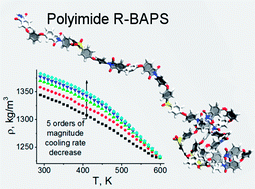Thermal properties of bulk polyimides: insights from computer modeling versus experiment
Abstract
Due to the great importance for many industrial applications it is crucial from the point of view of theoretical description to reproduce thermal properties of thermoplastic polyimides as accurate as possible in order to establish “chemical structure–physical properties” relationships of new materials. In this paper we employ differential scanning calorimetry, dilatometry, and atomistic molecular dynamics (MD) simulations to explore whether the state-of-the-art computer modeling can serve as a precise tool for probing thermal properties of polyimides with highly polar groups. For this purpose the polyimide R–BAPS based on dianhydride 1,3-bis(3′,4-dicarboxyphenoxy)benzene (dianhydride R) and diamine 4,4′-bis(4′′-aminophenoxy)biphenyl sulphone) (diamine BAPS) was synthesized and extensively studied. Overall, our findings show that the widely used glass-transition temperature Tg evaluated from MD simulations should be employed with great caution for verification of the polyimide computational models against experimental data: in addition to the well-known impact of the cooling rate on the glass-transition temperature, correct definition of Tg requires cooling that starts from very high temperatures (no less than 800 K for considered polyimides) and accurate evaluation of the appropriate cooling rate, otherwise the errors in the measured values of Tg become undefined. In contrast to the glass-transition temperature, the volumetric coefficient of thermal expansion (CTE) does not depend on the cooling rate in the low-temperature domain (T < Tg) so that comparison of computational and experimental values of CTE provides a much safer way for proper validation of the theoretical model when electrostatic interactions are taken into account explicitly. Remarkably, this conclusion is most likely of generic nature: we show that it also holds for the commercial polyimide EXTEM™, another polyimide with a similar chemical structure.


 Please wait while we load your content...
Please wait while we load your content...